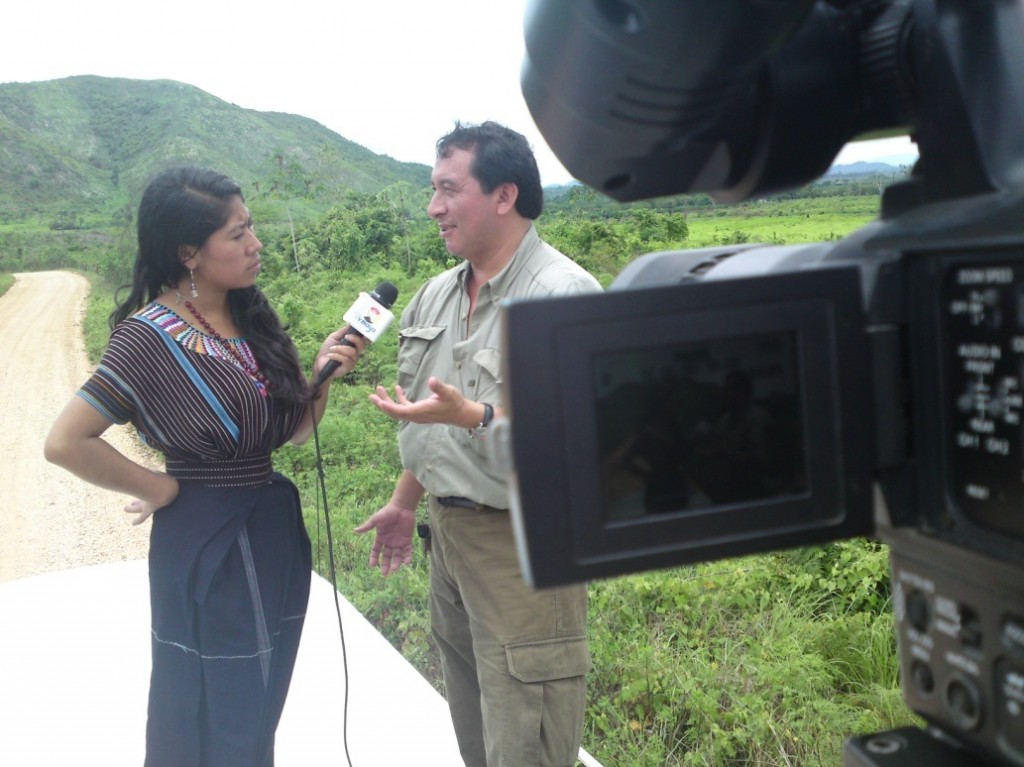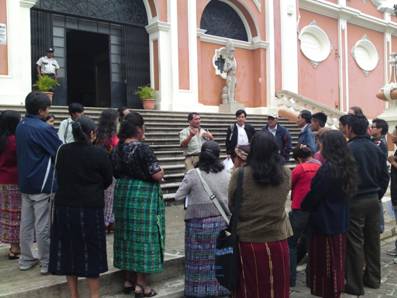THE WORK DONE IN GUATEMALA
EPIGRAPHY FOR THE MAYA PEOPLE
Antonio Cuxil
“A people with no history is like a tree with no roots”, says the famous saying (Marcus Garvey). And this is precisely what epigraphy, archaeology and other associated, auxiliary or inter-related sciences mean for the Maya people. I am not necessarily speaking on behalf of the Maya population at large, but I do believe that I do so for many of them. Epigraphy, together with archaeology, ethnology and anthropology are the sciences that have brought us, the Maya peoples, closer to our ancient History, since they are the disciplines that, together with linguistics, are more closely related to our people and they provide a very important link for the communication and transmission of History, which is a fundamental pillar for knowing any society’s past.
EL TRABAJO HECHO EN GUATEMALA
EPIGRAFIA PARA LOS MAYAS.
Antonio Cuxil
“Un pueblo sin historia, es como un árbol sin raíces”, reza el famoso refrán (Marcus Garvey). Y eso es precisamente lo que la epigrafía, arqueología, ciencias afines y auxiliares o interrelacionadas significan para el pueblo maya. No hablo necesariamente en nombre de toda la población maya en general, pero considero que si de una gran parte. La epigrafía conjuntamente con la arqueología, etnología y antropología son las ciencia que nos ha acercado más a los pueblos mayas con nuestra historia antigua, puesto que son las disciplinas, conjuntamente con la lingüística, que tiene más relación con nuestros pueblos, los cuales son un vínculo muy importante para la comunicación y transmisión de la historia, que es un pilar fundamental para conocer el pasado de cualquier sociedad.
There is a point in time where the link between epigraphy (History), archaeology and linguistics is lost and that link is the one that epigraphy has come to confirm and solidify, in order to link the Maya people more with our past; that is not to say that sciences such as archaeology, anthropology, ethnology and others are not important. Each of them has its place and we must acknowledge that epigraphy does not advance as much in the absence of archaeological discoveries or if it remains unlinked with linguistics; therefore, epigraphy without archaeology remains incomplete, while archaeology and other sciences remain incomplete without epigraphy. There is information that can only be confirmed through epigraphy, such as the date of accession or death of a certain ruler, or his date of birth. And there is information that can only be confirmed through archaeology or other auxiliary sciences. Thus, we can say that epigraphy has revolutionized the change from archaeology to History and that History (epigraphy) is the one that, in many aspects, is closer to the vocabulary, the worldview and the ceremonial language, among other things, used in our current modus vivendi as a contemporary Maya people.
I would like to share with our friends from “Friends of the Maya” some of the experiences we have had in our fieldwork, sharing the epigraphic knowledge that we have acquired at the Maya Meetings with people from some Communities. Sponsored and financed by CODISRA and PLFM.
This is the Beginner’s Workshop that we (Antonio Cuxil) gave with Héctor Xol in Guatemala City, in 2009.
This is one of the examples for practicing usage of the syllabary at the Huehuetenango Workshop given by Antonio Cuxil and Héctor Xol in 2009.
This is the Intermediate Level Workshop given at CODISRA in Guatemala City in July 2009.
At the Intermediate Level Workshop in July 2009, we thought that seeing the glyphs in person on the original monuments would bring a new dimension to the learning of epigraphy and we therefore decided to go see several monuments at Guatemala’s Museum for Archaeology and Ethnology and it was a fabulous experience.
Since the Theme of the Advanced Seminar with Doctor Nikolai Grube in 2009 was Teotihuacan and the Maya, I thought it would be good to see and explain the well-known Marcador from Tikal at the Museum for Archaeology in Guatemala; we spoke about Siyaj K’AK’, Atlatl Owl and their history in the Maya world.
In April 2010, we visited Nikolai Grube’s project in Uxul. Lolmay has always said: “I think we should go to the jungle and experience what researchers experience, in order to better understand the difficulties and obstacles they face in the jungle and thus be able to better appreciate the knowledge they bring to our classrooms”.
Equipment transfer and change of vehicle at the Calakmul Biosphere, en route to Uxul; Lolmay is the photographer.
In June 2010, Lolmay organized a cultural trip for the academy of Kakchiquel Mayan Languages, based in Chimaltenango and invited me to be the Group Guide, something to which I agreed immediately, feeling much honored; it was a very interesting experience, since we were also accompanied by a journalist and a cameraman from Maya Television, who were there for the purpose of filming and showing what the trip was like on Maya Television. In this photograph we are talking about: “The meaning and importance of the bajos (depressed part of the land, often prone to flooding) in the Petén and their implication for the apogee and decadence of Maya Civilization during the Classic period”.
Temple of the Inscriptions at Palenque during the trip made by the Academy of Maya Languages in June 2010.
After the journey to Palenque, we visited Tikal and this was also filmed for Maya Television, in order to show it on the cultural channel of Maya Television.
Also, Lolmay organized a Maya Epigraphy workshop on July 9 2010 for the Kakchiquel Linguistic community in Chimaltenango, where he invited me to help.
(Translation by Jorge Pérez de Lara)
Hay un espacio en el tiempo donde se pierde el vínculo entre epigrafía (historia), arqueología y lingüística, y ese vínculo es lo que la epigrafía viene a confirmar, solidificar y ligar al pueblo maya más con nuestro pasado, no quiero decir que las otras ciencias como la arqueología, la antropología, la etnología y otras afines no tienen una importancia. Claro que cada una tiene su lugar y debemos reconocer que la epigrafía no avanza en cierta manera o considerablemente si no hay nuevos descubrimientos arqueológicos, o si se desliga de la lingüística, por lo que la epigrafía sin la arqueología queda incompleta, y la arqueología y otras ciencias sin la epigrafía también están incompletas. Hay información que solamente se puede confirmar con la epigrafía, como por ejemplo el día de ascenso o muerte de determinado gobernante, o la fecha del nacimiento del mismo. Y hay información que solamente se puede confirmar con arqueología u otras ciencias auxiliares. De este modo, podemos decir que la epigrafía ha revolucionado el cambio de la arqueología a historia, y esa historia (epigrafía) es la que en muchos aspectos se asemeja al vocabulario, la cosmovisión y al lenguaje ceremonial, entre otros, en nuestro modus vivendi del pueblo maya contemporáneo.
Quiero compartir con nuestros amigos “Friends of the Maya” algunas experiencias que hemos tenido en el trabajo en el campo, compartiendo el conocimiento epigráfico que hemos aprendido en los Maya Meetings a la gente en algunas comunidades. Patrocinado y financiado por CODISRA y el PLFM
 Este es el Taller de Principiantes que dimos (Antonio Cuxil con Hector Xol) en Ciudad de Guatemala en 2009.
Este es el Taller de Principiantes que dimos (Antonio Cuxil con Hector Xol) en Ciudad de Guatemala en 2009.
 Este es uno de los ejemplos de practica de uso de silabario en el Taller de Huehuetenango dado por Antonio Cuxil y Hector Xol en 2009
Este es uno de los ejemplos de practica de uso de silabario en el Taller de Huehuetenango dado por Antonio Cuxil y Hector Xol en 2009
 Este es en el Taller de Intermedios dado en CODISRA en Ciudad de Guatemala en Julio del 2009.
Este es en el Taller de Intermedios dado en CODISRA en Ciudad de Guatemala en Julio del 2009.
 En el Taller de Intermedios en Julio 2009, creimos que ver los glifos en vivo y a todo color en los monumentos originales, le da una experiencia diferente a el aprendizaje de la epigrafia, por lo que decidimos ir a ver varios monumentos en el Museo de Arqueologia y Etnologia en Guatemala, y fue una experiencia grandiosa.
En el Taller de Intermedios en Julio 2009, creimos que ver los glifos en vivo y a todo color en los monumentos originales, le da una experiencia diferente a el aprendizaje de la epigrafia, por lo que decidimos ir a ver varios monumentos en el Museo de Arqueologia y Etnologia en Guatemala, y fue una experiencia grandiosa.
 Dado que el Tema del Seminario Avanzado con el Doctor Nikolai Grube en 2009 era Teotihuacan y Los Mayas, crei oportuno ver y explicar el conocido Marcador de Tikal en el Museo de Arqueología de Guatemala, hablamos de Siyaj K´ak´, Atlatl Tecolote, y sus historia en el Mundo Maya.
Dado que el Tema del Seminario Avanzado con el Doctor Nikolai Grube en 2009 era Teotihuacan y Los Mayas, crei oportuno ver y explicar el conocido Marcador de Tikal en el Museo de Arqueología de Guatemala, hablamos de Siyaj K´ak´, Atlatl Tecolote, y sus historia en el Mundo Maya.
 En Abril del 2010 visitamos el proyecto de Nikolai Grube en Uxul. “Lolmay siempre ha dicho, creo que debemos ir a la selva y vivir esa experiencia que pasan los investigadores, para comprender y entender las dificultades y vivencias que pasan en la selva, y asi apreciar mejor el conocimiento que nos traen a las aulas.”
En Abril del 2010 visitamos el proyecto de Nikolai Grube en Uxul. “Lolmay siempre ha dicho, creo que debemos ir a la selva y vivir esa experiencia que pasan los investigadores, para comprender y entender las dificultades y vivencias que pasan en la selva, y asi apreciar mejor el conocimiento que nos traen a las aulas.”
 Traslado de equipo y cambio de vehiculo en la Biosfera de Calakmul rumbo a Uxul. Lolmay es quien toma la fotografía.
Traslado de equipo y cambio de vehiculo en la Biosfera de Calakmul rumbo a Uxul. Lolmay es quien toma la fotografía.
 En Junio del 2010 Lolmay organizo un viaje cultural para la Academia de Lenguas Mayas Kakchiquel con sede en Chimaltenango, y me invito a ser el guia del grupo, al cual acepte con mucho honor inmediatamente, y fue una experiencia interesante, ya que también asistieron una reportera y un camarografo de la Television Maya para filmar y presentar dicho viaje en la Television Maya. En esta fotografía estamos hablando de: “El significado y la importancia de los Bajos en el area del Peten y su implicación en el auge y la decadencia de la Civilizacion Maya en el periodo Clasico”.
En Junio del 2010 Lolmay organizo un viaje cultural para la Academia de Lenguas Mayas Kakchiquel con sede en Chimaltenango, y me invito a ser el guia del grupo, al cual acepte con mucho honor inmediatamente, y fue una experiencia interesante, ya que también asistieron una reportera y un camarografo de la Television Maya para filmar y presentar dicho viaje en la Television Maya. En esta fotografía estamos hablando de: “El significado y la importancia de los Bajos en el area del Peten y su implicación en el auge y la decadencia de la Civilizacion Maya en el periodo Clasico”.
 Templo de las Inscripiones en Palenque durante el viaje de la Academia de Lenguas Mayas en Junio 2010.
Templo de las Inscripiones en Palenque durante el viaje de la Academia de Lenguas Mayas en Junio 2010.
Postriormente a el Viaje a Palenque realizamos una visita a Tikal y también este fue filmado por la Talevision Maya para presentarlo en el canal cultural de la Television Maya.
Asimismo Lolmay el 9 de Julio de 2010 organizó un taller de epigrafia Maya para la comunidad lingüística Kakchiquel en Chimaltenango donde me invitó a apoyar.










